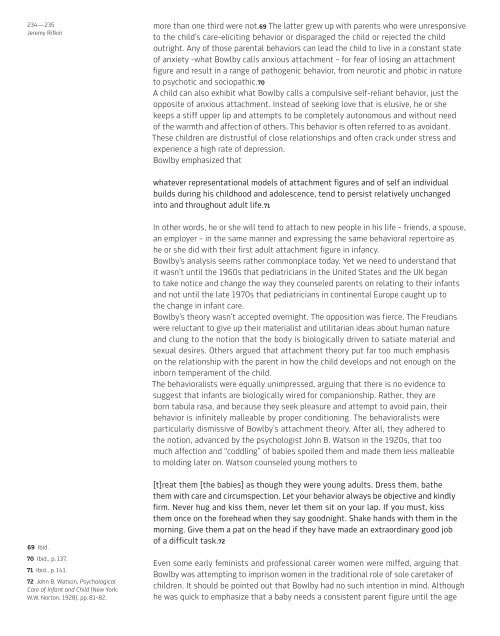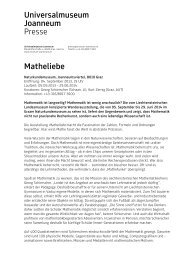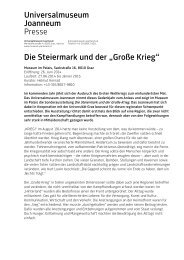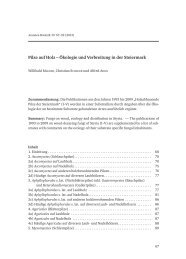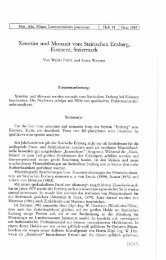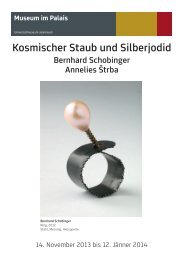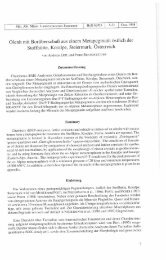Human Condition - Universalmuseum Joanneum
Human Condition - Universalmuseum Joanneum
Human Condition - Universalmuseum Joanneum
Erfolgreiche ePaper selbst erstellen
Machen Sie aus Ihren PDF Publikationen ein blätterbares Flipbook mit unserer einzigartigen Google optimierten e-Paper Software.
234 — 235<br />
Jeremy Rifkin<br />
69 Ibid.<br />
70 Ibid., p. 137.<br />
71 Ibid., p. 141.<br />
72 John B. Watson, Psychological<br />
Care of Infant and Child (New York:<br />
W.W. Norton, 1928), pp. 81–82.<br />
more than one third were not.69 The latter grew up with parents who were unresponsive<br />
to the child’s care-eliciting behavior or disparaged the child or rejected the child<br />
outright. Any of those parental behaviors can lead the child to live in a constant state<br />
of anxiety -what Bowlby calls anxious attachment – for fear of losing an attachment<br />
figure and result in a range of pathogenic behavior, from neurotic and phobic in nature<br />
to psychotic and sociopathic.70<br />
A child can also exhibit what Bowlby calls a compulsive self-reliant behavior, just the<br />
opposite of anxious attachment. Instead of seeking love that is elusive, he or she<br />
keeps a stiff upper lip and attempts to be completely autonomous and without need<br />
of the warmth and affection of others. This behavior is often referred to as avoidant.<br />
These children are distrustful of close relationships and often crack under stress and<br />
experience a high rate of depression.<br />
Bowlby emphasized that<br />
whatever representational models of attachment figures and of self an individual<br />
builds during his childhood and adolescence, tend to persist relatively unchanged<br />
into and throughout adult life.71<br />
In other words, he or she will tend to attach to new people in his life – friends, a spouse,<br />
an employer – in the same manner and express ing the same behavioral repertoire as<br />
he or she did with their first adult attachment figure in infancy.<br />
Bowlby’s analysis seems rather commonplace today. Yet we need to understand that<br />
it wasn’t until the 1960s that pediatricians in the United States and the UK began<br />
to take notice and change the way they counseled parents on relating to their infants<br />
and not until the late 1970s that pediatricians in continental Europe caught up to<br />
the change in infant care.<br />
Bowlby’s theory wasn’t accepted overnight. The opposition was fierce. The Freudians<br />
were reluctant to give up their materialist and utilitarian ideas about human nature<br />
and clung to the notion that the body is biologically driven to satiate material and<br />
sexual desires. Oth ers argued that attachment theory put far too much emphasis<br />
on the relationship with the parent in how the child develops and not enough on the<br />
inborn temperament of the child.<br />
The behavioralists were equally unimpressed, arguing that there is no evidence to<br />
suggest that infants are biologically wired for compan ionship. Rather, they are<br />
born tabula rasa, and because they seek plea sure and attempt to avoid pain, their<br />
behavior is infinitely malleable by proper conditioning. The behavioralists were<br />
particularly dismissive of Bowlby’s attachment theory. After all, they adhered to<br />
the notion, advanced by the psychologist John B. Watson in the 1920s, that too<br />
much affection and “coddling” of babies spoiled them and made them less malleable<br />
to molding later on. Watson counseled young mothers to<br />
[t]reat them [the babies] as though they were young adults. Dress them, bathe<br />
them with care and circumspection. Let your behavior always be objective and kindly<br />
firm. Never hug and kiss them, never let them sit on your lap. If you must, kiss<br />
them once on the forehead when they say goodnight. Shake hands with them in the<br />
morning. Give them a pat on the head if they have made an extraordinary good job<br />
of a difficult task.72<br />
Even some early feminists and professional career women were miffed, arguing that<br />
Bowlby was attempting to imprison women in the traditional role of sole caretaker of<br />
children. It should be pointed out that Bowlby had no such intention in mind. Although<br />
he was quick to emphasize that a baby needs a consistent parent figure until the age


